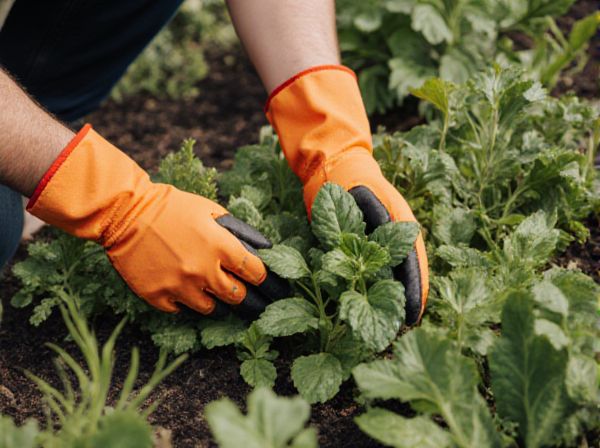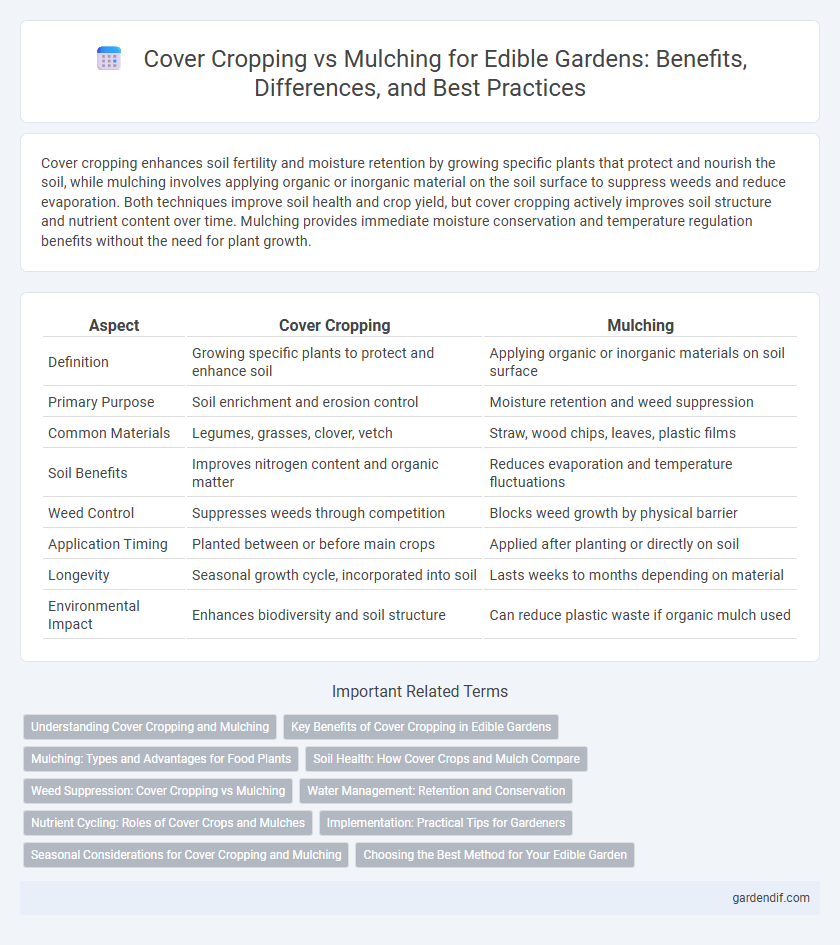
Cover Cropping vs Mulching Illustration
Cover cropping enhances soil fertility and moisture retention by growing specific plants that protect and nourish the soil, while mulching involves applying organic or inorganic material on the soil surface to suppress weeds and reduce evaporation. Both techniques improve soil health and crop yield, but cover cropping actively improves soil structure and nutrient content over time. Mulching provides immediate moisture conservation and temperature regulation benefits without the need for plant growth.
Table of Comparison
| Aspect | Cover Cropping | Mulching |
|---|---|---|
| Definition | Growing specific plants to protect and enhance soil | Applying organic or inorganic materials on soil surface |
| Primary Purpose | Soil enrichment and erosion control | Moisture retention and weed suppression |
| Common Materials | Legumes, grasses, clover, vetch | Straw, wood chips, leaves, plastic films |
| Soil Benefits | Improves nitrogen content and organic matter | Reduces evaporation and temperature fluctuations |
| Weed Control | Suppresses weeds through competition | Blocks weed growth by physical barrier |
| Application Timing | Planted between or before main crops | Applied after planting or directly on soil |
| Longevity | Seasonal growth cycle, incorporated into soil | Lasts weeks to months depending on material |
| Environmental Impact | Enhances biodiversity and soil structure | Can reduce plastic waste if organic mulch used |
Understanding Cover Cropping and Mulching
Cover cropping involves planting specific crops such as clover, rye, or vetch to improve soil health by enhancing nitrogen levels and preventing erosion, whereas mulching uses organic materials like straw, wood chips, or compost to conserve moisture and suppress weeds. Both practices contribute to sustainable farming by boosting soil fertility, improving water retention, and reducing the need for chemical inputs. Understanding the distinct roles of cover cropping and mulching allows gardeners and farmers to optimize crop yields and maintain long-term soil productivity.
Key Benefits of Cover Cropping in Edible Gardens
Cover cropping enriches soil fertility by fixing nitrogen, enhancing microbial activity, and reducing erosion in edible gardens. It suppresses weeds naturally, reducing the need for chemical herbicides and promoting healthier plant growth. These benefits improve crop yields and contribute to sustainable gardening practices.
Mulching: Types and Advantages for Food Plants
Mulching for food plants includes organic types like straw, wood chips, and compost, which enhance soil fertility and moisture retention while suppressing weeds. Inorganic mulches such as plastic films help regulate soil temperature and reduce evaporation, promoting healthier root development. These mulching techniques improve crop yields, reduce soil erosion, and decrease the need for chemical fertilizers in edible gardens.
Soil Health: How Cover Crops and Mulch Compare
Cover cropping enhances soil health by increasing organic matter, improving soil structure, and promoting beneficial microbial activity through living plant roots. Mulching conserves soil moisture, moderates temperature, and suppresses weed growth, contributing to overall soil stability without directly adding nutrients. Both practices support soil health but cover crops provide active soil enrichment, whereas mulch offers protective benefits.
Weed Suppression: Cover Cropping vs Mulching
Cover cropping significantly enhances weed suppression by competing for sunlight and nutrients, reducing weed seed germination through dense foliage and root systems. Mulching inhibits weed growth by blocking sunlight and forming a physical barrier, while also retaining soil moisture and moderating temperature. Combining cover crops and organic mulches can optimize weed control in edible gardens, minimizing reliance on herbicides and promoting healthier soil ecosystems.
Water Management: Retention and Conservation
Cover cropping enhances water retention by improving soil structure and increasing organic matter, which boosts infiltration and reduces runoff. Mulching conserves soil moisture by creating a barrier that limits evaporation and regulates soil temperature. Both practices are essential for sustainable water management in edible gardens, optimizing irrigation efficiency and promoting healthy plant growth.
Nutrient Cycling: Roles of Cover Crops and Mulches
Cover crops enhance nutrient cycling by fixing atmospheric nitrogen, increasing soil organic matter, and preventing nutrient leaching, which improves soil fertility for subsequent edible plants. Mulches conserve soil moisture and reduce erosion, while slowly releasing nutrients as they decompose, supporting nutrient availability in edible gardens. Combining cover cropping with mulching optimizes nutrient retention and promotes a healthy, productive soil ecosystem for sustainable edible crop production.
Implementation: Practical Tips for Gardeners
Cover cropping involves planting specific crops like clover or rye to improve soil health, suppress weeds, and enhance moisture retention, while mulching refers to applying organic materials such as straw, wood chips, or compost directly on the soil surface to conserve moisture and prevent erosion. Gardeners should select cover crops suited to their climate and planting schedule, ideally during off-seasons, and terminate them before seed set to maximize soil benefits. For mulching, apply a 2-4 inch layer around plants, avoid piling mulch against stems, and replenish regularly to maintain effective weed control and soil protection.
Seasonal Considerations for Cover Cropping and Mulching
Seasonal considerations for cover cropping emphasize selecting plant species that thrive in specific climates and growth periods, ensuring soil enrichment and erosion control during off-seasons. Mulching is best applied according to temperature fluctuations, providing insulation in winter and moisture retention during drier months for optimal plant health. Combining cover cropping with appropriate mulching strategies enhances overall soil fertility and crop yield throughout changing seasons.
Choosing the Best Method for Your Edible Garden
Cover cropping improves soil fertility and structure by adding organic matter and nitrogen through plants like clover or vetch, making it ideal for long-term soil health in edible gardens. Mulching, using materials such as straw, wood chips, or compost, conserves moisture, suppresses weeds, and regulates soil temperature, offering immediate benefits for crop growth. Selecting between cover cropping and mulching depends on the garden's specific needs for soil improvement versus weed control and moisture retention.
Cover Cropping vs Mulching Infographic

 gardendif.com
gardendif.com